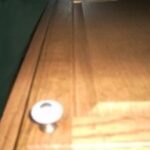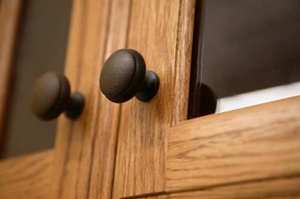Hanging kitchen cabinet doors is often the most difficult part of installing new cabinets. Improperly hung cabinet doors can emphasize a crooked ceiling or be crooked themselves. In order to do this job properly, plan on taking your time and having a helper to hold the cabinet doors in place as needed.
For this project, use interior mounted hinges. This type of hinge will conceal minor installation errors. Also if you must patch and redrill a hole, this mistake is easier to hide on the interior of a kitchen cabinet.
Start by taping the hinges to the interior of the doors using painter’s tape. Each hinge should be placed either 2 inches from the top or bottom of the door. If your doors are longer than 30 inches, plan on installing a third hinge in the center to further stabilize each kitchen cabinet door.
Drill pilot holes through the screw holes in the hinge and into the kitchen cabinet door. Make sure that you do not drill too deep and damage the front of the cabinet doors. Use a hand screwdriver to screw in screws that hold the cabinet door into place. Remove the painter’s tape once the hinges are secured to each door.
Use painter’s tape to mark the top of the cabinet doors. The line of painter’s tape should run across all of the cabinetry. This will ensure that all of the kitchen cabinet doors are level with one another.
Now is also the time to evaluate how the line appears in relation to your ceilings. If your kitchen ceilings are not level, you should carefully evaluate whether or not you would like to move the line very slightly to mask this irregularity. Keep in mind, however, that a larger difference will be apparent in the bottom of the kitchen cabinet doors.
Place one cabinet door over the hole in the cabinetry, making sure the top of the door lines up with the painter’s tape. Have your helper open the door slightly, and mark the location of the hinge and the needed screw holes with a pencil.
Predrill the holes for that door using an electric drill. With your helper holding the cabinet door into place, screw in the hinge hardware to secure the door. Once all of the screws have been installed, proceed to the next cabinet door.In order to do this job properly, plan on taking your time and having a helper to hold the cabinet doors in place as needed.
For this project, use interior mounted hinges. This type of hinge will conceal minor installation errors. Also if you must patch and redrill a hole, this mistake is easier to hide on the interior of a kitchen cabinet.
Start by taping the hinges to the interior of the doors using painter’s tape. Each hinge should be placed either 2 inches from the top or bottom of the door. If your doors are longer than 30 inches, plan on installing a third hinge in the center to further stabilize each kitchen cabinet door.
Drill pilot holes through the screw holes in the hinge and into the kitchen cabinet door. Make sure that you do not drill too deep and damage the front of the cabinet doors. Use a hand screwdriver to screw in screws that hold the cabinet door into place. Remove the painter’s tape once the hinges are secured to each door.
Use painter’s tape to mark the top of the cabinet doors. The line of painter’s tape should run across all of the cabinetry. This will ensure that all of the kitchen cabinet doors are level with one another.
Now is also the time to evaluate how the line appears in relation to your ceilings. If your kitchen ceilings are not level, you should carefully evaluate whether or not you would like to move the line very slightly to mask this irregularity. Keep in mind, however, that a larger difference will be apparent in the bottom of the kitchen cabinet doors.
Place one cabinet door over the hole in the cabinetry, making sure the top of the door lines up with the painter’s tape. Have your helper open the door slightly, and mark the location of the hinge and the needed screw holes with a pencil.
Predrill the holes for that door using an electric drill. With your helper holding the cabinet door into place, screw in the hinge hardware to secure the door. Once all of the screws have been installed, proceed to the next cabinet door.



